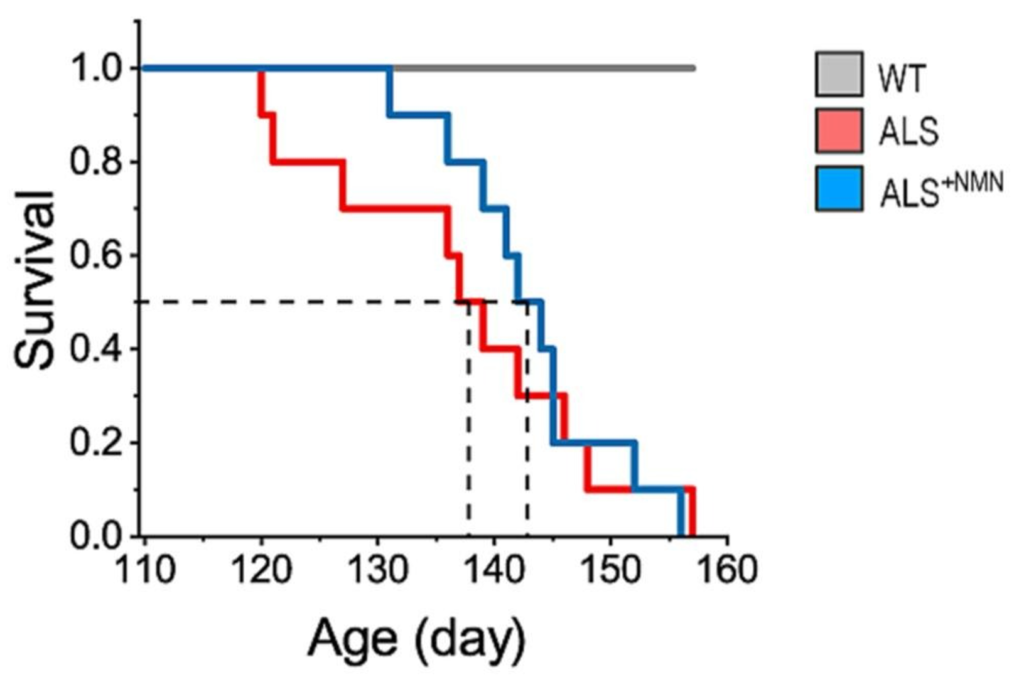New Study Shows NMN Prolongs the Lifespan of ALS Mice, by Boosting NAD+?
Nicotinamide mononucleotide (NMN) modestly extends the lifespan of ALS mice while improving symptoms but does not boost NAD+ levels in normal mice.
Highlights:
- Feeding NMN to ALS mice extends their median lifespan by about 3.5%.
- NMN delays the onset of movement dysfunction and preserves nerve-to-muscle signaling.
- NMN does not raise NAD+ levels in normal mice, but the researchers did not measure NAD+ levels in ALS mice.
As reported in Experimental Neurology, researchers from the University of Missouri have shown that NMN supplementation prolongs the lifespan of mice modeling ALS (amyotrophic lateral sclerosis), a.k.a. Lou Gehrig’s disease.

(Lundt et al., 2024 | Experimental Neurology) NMN Prolongs the Lifespan of ALS Mice. While normal mice (gray) live well beyond 160 days, ALS mice (red) have shortened lifespans. However, treating ALS mice with NMN (blue) modestly increases their median lifespan (Survival at 50% [0.5]).
Half of the ALS mice fed NMN (400 mg/kg) lived 5 days longer than mice not fed NMN, about a 3.5% increase in median lifespan. In humans, this is approximately equivalent to a 6-month increase in lifespan. Perhaps more meaningful, the first mortality event for the NMN-fed ALS mice was delayed by 2 weeks, equivalent to approximately 1 year for humans. While seemingly modest, this extra time could be substantial for ALS patients who on average survive 2 to 5 years after symptoms begin.
NMN-fed ALS mice also showed a two-week delay in motor dysfunction. They were able to do things like spend more time running on a rotating rod without falling and hanging from wires without dropping. Considering that ALS patients often lose control of their movements, these findings suggest that NMN could potentially defer such symptoms.

Still, while NMN supplementation preserved some muscle mass in ALS mice, it did not lead to improvements in strength. Therefore, while NMN may protect against muscle atrophy, it may not counteract the profound muscle weakness suffered by ALS patients. On the other hand, NMN showed signs of preserving the electrical signaling between the muscles and nerves of ALS mice.
Such results could be important because the nerves joining the spinal cord and limb muscles of ALS patients degenerate over time. This neurodegeneration disrupts the communication between the brain and limbs, manifesting in paralysis. For this reason, ALS patients require a wheelchair to remain mobile.
While hopeful, the authors admit the effects of NMN on ALS nerve degeneration are limited and suggest that NMN could be used in combination with other interventions. Specifically, it could be paired with compounds that inhibit the breakdown of NAD+. They say,
“The effects of NMN alone on the spinal cord may be limited. As such, pairing NMN with other interventions, such as the inhibitors of NAD+-consumers, may elicit stronger benefits.”
Such inhibitors include compounds not yet on the market like 78c, which blocks the CD38 enzyme from breaking down NAD+. Mayo Clinic scientists have shown that 78c prolongs the lifespan of aging mice. Furthermore, natural CD38 inhibitors like apigenin, which was recently shown to protect against brain aging, are now available.
Alternate Non-NAD+ Boosting Effects of NMN?
The Missouri University researchers found that ALS mice exhibited a progressive decrease in NAD+ levels that paralleled the progression of ALS symptoms. It follows that the observed effects of NMN on the ALS mice were a result of replenishing NAD+ levels. However, the researchers did not see a significant increase in NAD+ levels upon NMN supplementation.

(Lundt et al., 2024 | Experimental Neurology) NMN Does Not Raise NAD+ Levels. Mice on a normal diet (gray) and mice on a diet containing NMN (red) did not have significantly different NAD+ levels (Normalized NAD).
“While NMN is a precursor of NAD+, no observed effect on NAD+ levels could suggest that the benefits from NMN could be a mechanism different from NAD+ homeostasis,” said the authors.
Before speculating on the alternate effects of NMN, it should be pointed out that the researchers did not measure NAD+ from the ALS mice after NMN supplementation. This is surprising, considering that they measured NAD+ from these mice without NMN supplementation. Therefore, without being measured, it is unclear whether NMN could have elevated NAD+ levels in these ALS mice.
Notably, the ALS mouse model used in the study is based on a genetic mutation in the SOD1 gene that few ALS patients have. The authors say,
“SOD1 mutations comprise a small percentage of total ALS cases, as such, whether NMN has a similar impact on the majority of ALS cases is unknown.”
With this in mind, studies testing the effects of NMN on other ALS models may clarify whether NMN boosts NAD+ levels in ALS. Also, considering that another NAD+ precursor NR, when combined with pterostilbene, has been shown to reduce disease severity in ALS patients, NMN could potentially have similar effects.
Model: SOD1 transgenic mouse model for amyotrophic lateral sclerosis (ALS)
Dosage (oral): 400 mg/kg/day of NMN in food

